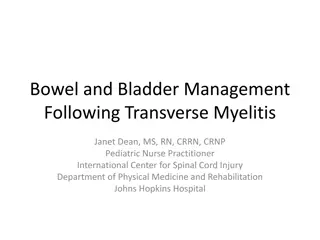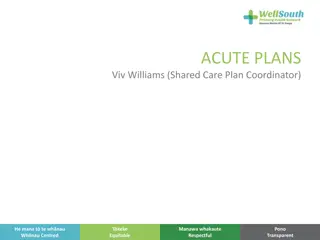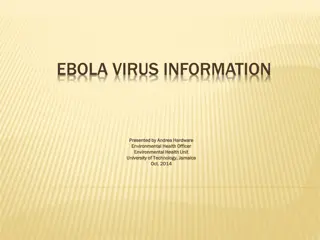Emerging Health Threats: Ebola, Measles, and Acute Flaccid Myelitis Updates
The Democratic Republic of the Congo faced its 10th Ebola outbreak in 2018, with 608 reported cases. Measles cases in the U.S. surged between 2009-2014 due to lack of vaccination, while Acute Flaccid Myelitis causes muscle weakness. These health threats are significant and require attention to prevent further spread.
Download Presentation

Please find below an Image/Link to download the presentation.
The content on the website is provided AS IS for your information and personal use only. It may not be sold, licensed, or shared on other websites without obtaining consent from the author.If you encounter any issues during the download, it is possible that the publisher has removed the file from their server.
You are allowed to download the files provided on this website for personal or commercial use, subject to the condition that they are used lawfully. All files are the property of their respective owners.
The content on the website is provided AS IS for your information and personal use only. It may not be sold, licensed, or shared on other websites without obtaining consent from the author.
E N D
Presentation Transcript
Health and Human Resources Sub-Panel Meeting Emerging Health Threats Jonathan Falk, MPH Epidemiology Program Manager 1
Ebola 2
Ebola August 1st, 2018 Democratic Republic of the Congo (DRC) reported an outbreak of Ebola virus disease (EVD) 10th Ebola outbreak in the DRC since the virus was discovered in 1976 608 cases of EVD have been reported as of January 1st, 2019 560 Confirmed 368 Deaths (61% CFR) 6,859 contacts under surveillance as of January 1st, 2019 54,153 people vaccinated as of January 1st, 2019 3
Measles 6
Measles Acute viral illness characterized by a prodrome of fever and fatigue, cough, coryza, and conjunctivitis, followed by a maculopapular rash Usually a mild or moderately severe illness but can result in complications such as pneumonia, encephalitis, and death Average interval between exposure and rash onset is 14 days Infectious period is typically four days before until four days after onset of rash 7
Measles 1,264 measles cases were reported in the U.S. from 2009-2014 Compared to 557 from 2001-2008 Approximately 90% of those cases were unvaccinated or had an unknown vaccination status Approximately 95% of those cases were linked to imported cases 11
Acute flaccid myelitis (AFM) It affects the area of the spinal cord called gray matter, which causes the muscles and reflexes in the body to become weak. Most of the patients with AFM (more than 90%) had a mild respiratory illness or fever consistent with a viral infection before they developed AFM. Viral infections such as from enteroviruses are common, especially in children, and most people recover. Unknown why a small number of people develop AFM, while most others recover. 13
Acute flaccid myelitis (AFM) These AFM cases are not caused by poliovirus; all the stool specimens from AFM patients that we received tested negative for poliovirus. Most patients have had onset of AFM between August and October, with increases in AFM cases every two years since 2014. At this same time of year, many viruses commonly circulate, including enteroviruses, and will be temporally associated with AFM. Most AFM cases are children (over 90%) and have occurred in 46 states and DC. 14
Hepatitis A 16
Hepatitis A Acute viral illness characterized by fever, fatigue, loss of appetite, nausea, vomiting, abdominal pain, dark urine, clay-colored stools, joint pain, and jaundice Illness can last for several weeks but most recover completely without lasting liver damage. In serious situations, hepatitis A can cause liver failure and death. Average interval between exposure and symptoms is 28 days but can occur between 15 and 50 days Infectious period can begin up to two weeks prior to symptom onset 17
Hepatitis A Since March 2017, CDC has been assisting several states with hepatitis A outbreaks, spread through person to person contact, that have occurred primarily among persons who use injection and non- injection drugs, and/or persons who are homeless, and their close direct contacts. Virginia is currently not considered an outbreak state but has been working with CDC and local health districts to monitor and prepare for possible outbreak-related cases 18
West Virginia Kentucky Tennessee North Carolina Cases 2,137 3,265 597 51 Hospitalization rate 50% 50% 63% 76% 19
Influenza 20
2018-2019 Influenza Season Virginia reported Widespread influenza activity for the week ending December 29, 2018 This is the first week at Widespread for the current flu season According to the CDC, Flu activity is unlikely to have peaked and is expected to continue nationally for many weeks. Flu activity peaked in early February during the 2017-18 flu season
Geographic Distribution of Influenza-Like Illness (ILI)























